Rider, Thomas (McKechnie Section 3)
See also Sections Two, Four and Five, and Rider and Bazing in this Section
An artist who signed his work ‘T. Rider’ was recorded by Jackson (The History of Silhouettes) and Mills. In her Dictionary Jackson heads her entry (which begins with a reference to Trade Label No.1) ‘L. T. Rider’, and later refers to a signature, ‘J.R.’ I have not seen the signature ‘L. T. Rider’, nor do I know of any specialist who has. Mayne (presumably following Jackson) gives the initiais ‘L. T.’
It is possible that Rider was the son of Thomas Ryder (1746-1810), the engraver who specialized in stipple work and was employed by Boydell, the manager of the Shakespeare Gallery (see Section One). Jackson (Dictionary) in an entry on T. Ryder, quotes part of an advertisement: ‘Any lady or gentleman in the country by taking their own shade can have reduced for 3s. 6d. rings in the new method which has the effect of topazes.’ The likelihood that T. Ryder and Rider the profilist were the same man is suggested by the phrase ‘the effect of topazes’, which is very similar to the phrase ‘the effect of a topaz’ quoted on Rider’s Trade Label No. 3 and for which I know no parallel in any announcement by any other British profilist.
As a student Thomas Ryder, the engraver, worked with James Basire I (1730-1802; see the entry on Rider and Bazing), another fine engraver who at one time also worked for Boydell. It was from Basire's address (Great Queen Street, Lincoln’s Inn Fields, London) that Thomas Ryder exhibited work at the Free Society of Artists during the 1760s. I have found no corresponding address, however, for Rider the profilist, nor are there any references to engraving or to prints on any of Rider’s trade labels, apart from the mention of the making of convex glasses for framing prints on his Trade Label No. 2. Bénézit and other authorities state that Thomas Ryder had a son of the same name who was also working during the eighteenth and nineteenth centuries. Since his surname is spelt in the same way as that of the engraver who issued the advertisement quoted by Jackson, it is possible that he may have been Thomas Rider the profilist. He may have altered the spelling of his name to ‘Rider’ to avoid the risk of being confused with his better known father.
Several addresses of Rider (all in London) are known from his trade labels. No. 1 gives the address 8 Charles Street, but for the period 1784-1801 the relevant rate books (for St Paul’s, Covent Garden) do not list Rider’s name. On the other hand, the Harleian transcripts of the registers for this parish show many mentions of the name Rider. One record (1799) lists a T. Rider as a witness to a wedding and states that a son, Thomas, of Thomas and Ann Rider, was christened in that year. Either of these references might indicate T. Rider (or Ryder) the silhouette artist.
Two other addresses of Rider, apparently used later, were 408 Strand (used in partnership with Bazing) and 85 Long Acre (Trade Label No. 2), both in the parish of St Martin’s-in-the-Fields. The contemporary rate books for this parish, however, do not list the name Rider, nor do London directories for 1780-1805 mention anyone of this name. Trade Label No. 3 gives the address ‘at Mr. Billington’s, Printseller, Temple Bar.’ Bénézit lists one artist of this name: Horace W. Billington, a painter who exhibited at the Royal Academy in 1802 from an address at 7 Cornhill. He was brother-in-law of the singer Elizabeth Billington and died in 1812. Billington may have been the printseller at Temple Bar and have been acquainted with the Ryder family, and have provided accommodation for the profilist (if indeed he was the son of Thomas Ryder the engraver).
So little of Rider’s work is available for examination that it is impossible to assess how long he worked as a profilist. The earliest illustrated profile is the example, backed with gold leaf, in the Kilner collection; it was taken in c. 1786. It bears the handwritten address 8 Charles Street, Covent Garden. Another example, owned by myself, dates from c. 1788 and bears Trade Label No. 1, which gives the same address. Jackson implicitly gives the date 1789 for Trade Label No. 2, bearing the address 85 Long Acre, and Mills lists Rider at Temple Bar for the same year.
Changes in prices charged, which often help to decide the order in which trade labels were used, are of little assistance in Rider’s case. Only on one of his labels (No. 3) are prices given: ‘from 2s. 6d. to £1/1s’. As there is no evidence that Rider produced any full-length work (nor, as he was an exponent of gold-leaf technique — as the phrase ‘effect of topazes’ presumably indicates — is it likely that he would have produced any) the highest price mentioned on this label was probably charged for jewellery pieces framed in gold. The advertisement (1789) quoted by Jackson gives the price of 3s 6d for rings, thereby suggesting the possibility that by this stage Rider had taken up producing jewellery pieces (painted on glass backed with gold leaf, not on ivory) for which he could charge more than for other work, and that he used Trade Label No. 3 later than his other labels.
Rider’s glass profiles are rare, and vary both in size and in style. They are painted on convex glass. Two bust-length profiles of women are of conventional size (3¾ x 2¾ in.). Another bust-length profile, in an oval pearwood frame, signed in the corner (the name was scratched with a needle and backed with gold foil) has been seen which measures as much as 8 x 6 in. (This example was sold by Sotheby and Company, London, on 26 April 1971). One silhouette of a woman, owned by myself, appears to have been painted in oil colour, which was thinned in order to provide a base for rough strokes in dead black, designed to show the formation of the â la conseilleur hair-style. The sitter’s buffon shows similar treatment. There is no sign of the use of a needle (which is difficult to employ with oil pigment). Nor does Rider appear to have used a needle for his silhouettes painted in water-colour. One of these is backed with gold foil; the work on it is better than that on the other illustrated examples.
1138
One illustrated silhouette (with a white background) is coated with a thin layer of gesso, and is not backed with a plaster slab.
1139
On Trade Label No. 1 Rider refers to gold backing on his work. On Trade Labéls Nos 2 and 3 he mentions ‘gold borders’ and on No. 3 he calls himself the ‘Inventor’ of convex glasses. Since this label cannot be dated with accuracy, we do not know whether Rider’s claim was valid; since we do know that Edward Beetham had learnt the art of verre églomisé by 1785, Rider’s statement was probably unfounded (unless he had invented his own method of producing verre églomisé).
Rider's jewellery work needs special mention. More than once he refers to 'rings on crystals which have the effect of a topaz'. As I have suggested above, these were doubtless backed with gold leaf (as were similar Continental pieces dating from that time) possibly with verre églomisé borders, and must have been very fine, but I have not seen any exam-ples. On Trade Label No. 1 he also mentions work showing 'Coats of Arms, Crests, Cyphers, Writing or any Device, wrought in Gold, on Glass': probably a reference to elaborate verre églomisé pieces.
The possibility that Rider made ‘obituary’ silhouettes is discussed in Section Two; it is possible that he painted some examples of these on glass.
The question of enamelled portraits occurs in connection with Rider, who uses the word ‘enamel’ on three of his trade labels. On No. 1 he offers work ‘in a rich and Curious style on Enamel, and also in Glass with a gold ground’; on No. 2 he offers work ‘finished on convex glasses with an elegant gold border, which makes them equal to the finest enamel’. The reference to enamel on No. 3 is similar to that on No. 2. The first paragraph of Trade Label No. 1 suggests that Rider did at some time offer enamel portraits proper, as well as portraits painted or ‘enamelle’ on glass. His silhouettes painted in oil colour, and backed with a coating of gesso, do have an enamel-like appearance, and it is possible that it was these examples that Rider had in mind when referring to his ‘enamel’ work. (The question of ‘enamel’ silhouettes in general is discussed in Chapter Two).
As I have mentioned, three trade labels of Rider are known. No. 1 (of which there is an example in my collection) contains the apparent reference to work ‘on Glass with a Gold Ground’:
LIKENESSES
Taken in Miniature, profile and finished in a rich and Curious Stile on Enamel, also on Glass with a Gold Ground, in a Manner entirely new. Coats of Arms, Crests, Cyphers, Writing or any Device, wrought in Gold, on Glass.
Persons having Likenesses in Shade of their deceased Friends, may have them reduced or copied and emblematically represented in a curious Manner. Large Shades reduced within the Compass to be worn in a Ring, Pin, Locket or Bracelet, on Enamel, Ivory, or Paper, and the Likeness carefully preserved, and dressed in the present Taste, by
T. RIDER, PROFILIST
No. 8, Charles Street, Covent Garden
N.B. He preserves the Originals and can supply those he has once taken with any number of Duplicates, and have them carefully conveyed either by [illegible], or elsewhere.
No. 2 is quoted by Jackson (Dictionary), apparently the only work in which the initials ‘L. T.’ are given:
[ ?L.] T. RIDER
Profilist
85, Long Acre
Profile Likenesses
Taken in miniature and finished on convex glasses with an elegant gold border which makes them equal to the finest Enamel, and which for beauty and Likeness is not to be equalled in Europe.
Also Miniature Portraits, Prints or framings mounted in the above manner in Convex Glasses by a Method entirely new and known to noone in England but himself, is thought worthy of a Place in some of the first private Cabinets in the Kingdom, and is much sought after by the curious.
No. 3 reads:
RIDER
Profilist
Inventor of Gold Borders on Convex glasses which gives a Painting, Print, or Drawing the effect of finest enamel.
Any Lady or Gentleman in the Country, by taking their own Shades, may have them reduced from 2s. 6d. to £1/1s. Particularly in his new manner for Rings on Crystals which have the effect of a Topas, — Time of Sitting one Minute.
At Mr. Billington’s, Printseller, Temple Bar.
If the dates given by Jackson and Mills are correct, then all three labels must have been used durng the 1780s.
Inscriptions of Rider are known. One (from the reverse of a profile, backed with gold foil, in the Kilner collection) is illustrated. Also Rider often inscribed his work by scratching his name with a needle near the bust-line; known variants are ‘Rider’ and ‘T. Rider’.
Ills. 1138-1142
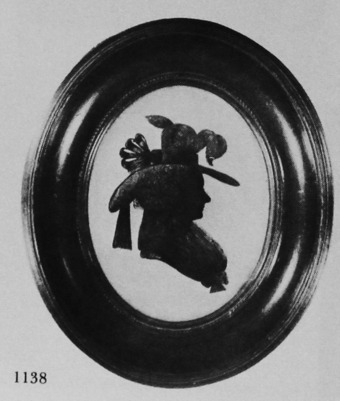
Unknown woman
Silhouette painted on convex glass in water-colours, with background of gold foil border
c. 1786
3 ¾ x 2 ¾ in./96 x 70mm.
Signed ‘T. Rider’ and inscribed on the reverse, ‘T. Rider, Profilist, No. 8, Charles Street, Covent Garden’.
R. Kilner collection
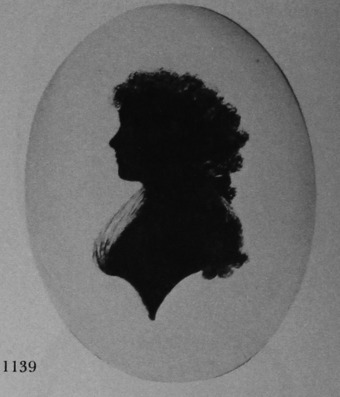
Unknown woman
Silhouette painted on convex glass in oil; backed with white gesso
c. 1788
3 ½ x 2 ¾ in./90 x 70mm.
Trade Label No. 1
Frame: pearwood
Author’s collection
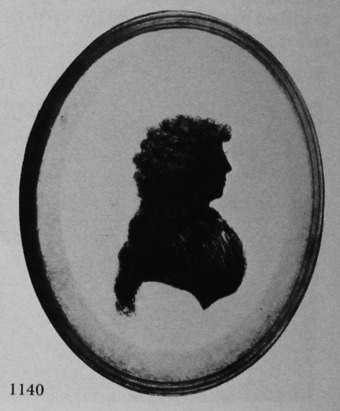
Mrs Wyatt
Silhouette painted on convex glass
1789
3 ½ x 2 ¾ in./90 x 70mm.
From Weymer Mills, ‘One Hundred Silhouette from the Wellesley Collection’ (1912), by courtesy of the Oxford University Press
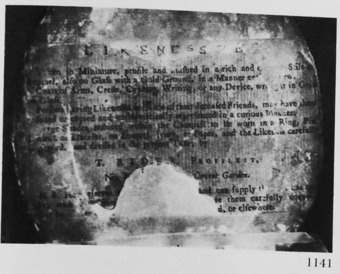
Trade Label No. 1 of T. Rider.
Author’s collection
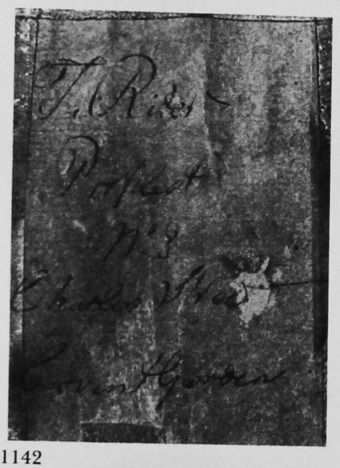
Inscription of T. Rider, from the reverse of the silhouette illustrated in 1138.
R. Kilner collection
